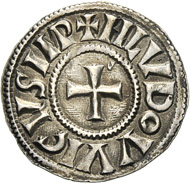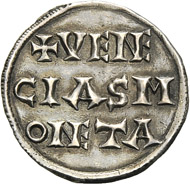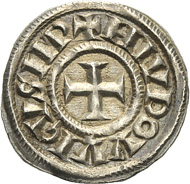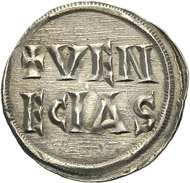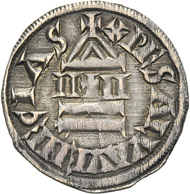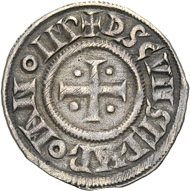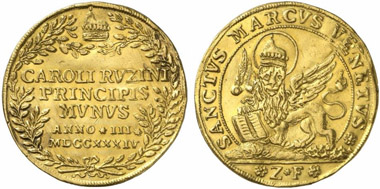The whole problem of the fishermen in the Lagoon started when Carloman died, younger brother of Charles, later to be nicknamed ‘the Great’ (Charlemagne). Immediately, Charles seized the fraternal heritage, to the great displeasure of Carloman’s wife who asked his father, king of the Lombardic Empire, for help on behalf of her under age sons. The only thing she reached by that, however, was that Charles conquered the Lombard Empire as well. In 774, he took the iron crown in Pavia. When he bent his steps to Aachen again, he left his son Pippin who had the order to bring all of Northern Italy under the control of the Carolingians.
That was the time when the humble fishermen and merchants, hitherto staying in Malamocco, retreated to the relatively safe Rivo Alto (= ‘high bank’, present-day Rialto). In 809, Pippin seized Malamocco. The Venetians tend to prefer quite a different version of that story: Pippin hadn’t been able to conquer the true Venice at all! Admittedly, he tried to build a bridge of boats to Rivo Alto, but the LORD had sent his floods, the horses had baulked, and the entire army had sunk like those of Pharaoh in the Adriatic Sea.
However, in 812 anyway, Venice was independent again. Well, not officially, that is. Theoretically speaking, Charlemagne had granted the Byzantine emperor Venice, Dalmatia and Istria in the Treaty of Aachen, in exchange for the recognition of his own imperial title as equal partner in the West. But the Byzantine emperor was remote, and Venice flourished as hub between East and West. In the early 9th century, it wasn’t luxurious goods that made the money bags rich but dried cod which became an export hit with the beginning of the Christianization in the West. Fish was fasting food – and hard to come by in the interior. Thus, Venice supplied the dried fish. And salt. And crop, olive oil, wine, slaves, anything that was required. Individual bold salesmen crossed with their small ships the Adriatic Sea and reached Sicily, Greece, Syria and Egypt. That was extremely useful at a time when the Carolingians again tried to get their hands on Venice.
Louis the Pious. Denarius, Venice, around 819-822. Of great rarity. From the collection of Count Zoppola and Pierre Stettiner. From upcoming Künker sale, Collection Edoardo Curti (March 2013), lot 2133. Estimate: 15,000 euros.
In his chronicle, John the Deacon told the remarkable story of a conspiracy in Venice; two men who participated in a revolt against the Doge, which had been appointed by Byzantium, had fled to King Lothair, son of Louis the Pious. Their house and their goods had been confiscated in Venice. One of the two men, called Johannes Tornaricus, was a ‘monetarius’, hence a mint master …
Louis the Pious. Denarius, Venice, 820-825. From upcoming Künker sale, Collection Edoardo Curti (March 2013), lot 2140. Estimate: 1,400 euros.
Alan Stahl, in his monumental work on the coinage of Venice, tries to link these interesting denarii, which have no connection with the real power relations in Venice at the time they were minted, to this rebellious mint master. In his opinion, this is the only way to relate the real political situation with the extant coins.
At any rate, the highest circles at the imperial court tried to make Venice see reason. And indeed, in 827, the coup was achieved: the Synod of Mantua decided that only the patriarch of Aquileia was to be regarded true patriarch. At first sight, that doesn’t seem very spectacular. But the Venetians instantly saw through the hidden agenda. Until then, the bishop of Grado had been responsible for them. The patriarch of Aquileia, in contrast, was appointed by the Carolingians. It seemed likely that, under the cloak of religious policy, Carolingian control had entered the Lagoon.
A patriarch was a clerical authority whose power was solely based on the belief that, according to tradition, initially the first officeholder had been appointed by an apostle. The patriarchy of Aquileiy was proud of having been founded by Saint Mark himself. It suited the Venetians’ book that a merchant arrived from the East to sell a load of relics with reasonable profit in the Carolingian Empire. The owner of the ship claimed that he had transported Saint Mark from Alexandria in his cargo hold. The Venetian political realists at once spotted the chance available to them: saints were a political criterion – in the entire Middle Ages. The holy relics were thought to choose freely the place where they wanted to be venerated. Thus, the ‘free’ choice of Saint Mark to settle down in Venice was the perfect reason to be played off against the patriarch of Aquileia whose church didn’t possess the least bonelet of the Saint’s body.
Venice. Denarius, 9th century, probably 829-836(?). From upcoming Künker auction, Collection Edoardo Curti (march 2013), lot 2240. Estimate: 12,500 euros.
No wonder that this holy body was considered much too precious to entrust it to the church. He was translated to the Doge’s private chapel where he still lies, in San Marco. No wonder, too, that the Venetians issued coins that were highly diplomatic. ‘May Christ protect Venice’ was hardly something offensive. And, ‘May our LORD protect the Roman Emperor’ likewise was completely innocuous. It was left to the user’s reading whether the Byzantine or the Western emperor was meant by that.
Was it Saint Mark who maintained the relative independence between the empires in Venice? At any rate, several centuries later, when the city at the Lagoon flourished, the final version of the tale how Saint Mark came to Venice was formulated: according to the chronicle of Doge Andrea Dandolo, a wicked caliph had planned to destroy the churches of Alexandria. Back then, a storm happened to bring two pious merchants from Venice to Alexandria. They headed for the church at once in order to pray, and engaged in conversation with the lamenting priests. They were afraid that Saint Mark, who was buried in their church, wouldn’t be able to receive the veneration he was entitled to anymore. Soon, the agreement was reached to translate the relics to pious Venice. The transport of the completely preserved body of the Evangelist was eased by heavy rainfall god had sent.
The Muslim publicans recoiled at the ham that completely covered Saint Mark. This was the miraculous way in which the Saint’s remains came to Venice, to protect the Serenissima when she advanced to become one of the greatest powers of the Mediterranean region.
Venice. Gold osella 1734. From Künker auction 221 (2012), estimated at: 2,000 euros, hammer price: 3,000 euros.
It is a nice story the Venetians thought to be true for centuries. They considered themselves among the chosen by Saint Mark who erected their lions of Saint Mark all in the Mediterranean region.
This link will bring you directly to the latest Künker sale.





